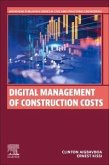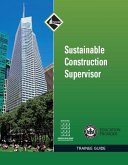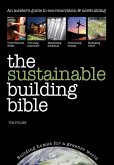Recent Developments and Innovations in the Sustainable Production of Concrete
Herausgeber: Khan, Afzal Husain; Bani-Hani, Khaldoon A; Akhtar, Mohammad Nadeem
Recent Developments and Innovations in the Sustainable Production of Concrete
Herausgeber: Khan, Afzal Husain; Bani-Hani, Khaldoon A; Akhtar, Mohammad Nadeem
- Broschiertes Buch
- Merkliste
- Auf die Merkliste
- Bewerten Bewerten
- Teilen
- Produkt teilen
- Produkterinnerung
- Produkterinnerung
Recent Developments and Innovations in the Sustainable Production of Concrete covers the various aspects of sources, materials, and waste products in concrete production, innovation in materials-new technological developments, and the upgradation of existing concrete production systems. Importantly, it covers the so-called EEE aspects (Economy, Energy, and Environment), not touched by other books. The books also highlights the sustainability aspects of concrete production when recycled materials are added. Case studies are used to demonstrate the practical aspect of concrete production, including the machine learning approach.…mehr
Andere Kunden interessierten sich auch für
![Membranes for Structures Membranes for Structures]() Membranes for Structures250,99 €
Membranes for Structures250,99 €![Plastics Now Plastics Now]() Billie FairclothPlastics Now84,99 €
Billie FairclothPlastics Now84,99 €![Digital Management of Construction Costs Digital Management of Construction Costs]() Clinton AigbavboaDigital Management of Construction Costs147,99 €
Clinton AigbavboaDigital Management of Construction Costs147,99 €![Sustainable Construction Supervisor Trainee Guide Sustainable Construction Supervisor Trainee Guide]() NccerSustainable Construction Supervisor Trainee Guide72,99 €
NccerSustainable Construction Supervisor Trainee Guide72,99 €![The Sustainable Building Bible The Sustainable Building Bible]() Tim PullenThe Sustainable Building Bible17,99 €
Tim PullenThe Sustainable Building Bible17,99 €![Implementing Virtual Design and Construction Using Bim Implementing Virtual Design and Construction Using Bim]() Lennart AnderssonImplementing Virtual Design and Construction Using Bim58,99 €
Lennart AnderssonImplementing Virtual Design and Construction Using Bim58,99 €![Adaptive Thermal Comfort: Foundations and Analysis Adaptive Thermal Comfort: Foundations and Analysis]() Michael HumphreysAdaptive Thermal Comfort: Foundations and Analysis69,99 €
Michael HumphreysAdaptive Thermal Comfort: Foundations and Analysis69,99 €-
-
-
Recent Developments and Innovations in the Sustainable Production of Concrete covers the various aspects of sources, materials, and waste products in concrete production, innovation in materials-new technological developments, and the upgradation of existing concrete production systems. Importantly, it covers the so-called EEE aspects (Economy, Energy, and Environment), not touched by other books. The books also highlights the sustainability aspects of concrete production when recycled materials are added. Case studies are used to demonstrate the practical aspect of concrete production, including the machine learning approach.
Produktdetails
- Produktdetails
- Verlag: Elsevier Science
- Seitenzahl: 712
- Erscheinungstermin: 20. November 2024
- Englisch
- Abmessung: 229mm x 156mm x 33mm
- Gewicht: 1120g
- ISBN-13: 9780443238956
- ISBN-10: 0443238952
- Artikelnr.: 69926028
- Herstellerkennzeichnung
- Libri GmbH
- Europaallee 1
- 36244 Bad Hersfeld
- gpsr@libri.de
- Verlag: Elsevier Science
- Seitenzahl: 712
- Erscheinungstermin: 20. November 2024
- Englisch
- Abmessung: 229mm x 156mm x 33mm
- Gewicht: 1120g
- ISBN-13: 9780443238956
- ISBN-10: 0443238952
- Artikelnr.: 69926028
- Herstellerkennzeichnung
- Libri GmbH
- Europaallee 1
- 36244 Bad Hersfeld
- gpsr@libri.de
Section A - Sources, materials, and waste products in concrete production
1. Valorization of industrial and agro-waste materials for production of
green construction materials
2. A comprehensive study of concrete performance by using bacterial calcite
precipitation
3. Self-compacting recycled aggregate concrete: future scope and challenges
4. Recent advances in microbiology in producing self-healing concrete
5 Geopolymer concrete: an innovative approach for sustainable
infrastructure and advancement in circular economy
6. Ultrahigh-performance concrete: a new additive material in construction
industry
7. Silica fume as sustainable supplementary cementitious materials in
concrete
8. Cement replacement using pozzolanic materials: a sustainable approach
9. Mechanical and durability properties of bacteria-based admixed
self-healing concrete under different exposures
Section B - Economy, energy, and environment aspects in concrete production
10. Eco-efficient pavement construction materials
11. Crumb rubber as an eco-friendly aggregate in sustainable concrete:
properties, integration, and future perspectives
12. Sustainability measurement of developed concrete by incorporating solid
waste
13. Economic feasibility of a large-scale adoption of silica fume in
construction
14. Circular economy in the construction sector: current trends and future
outlook
15. Use of stabilized waste soil in the construction of sustainable
concrete
16. Recycled aggregate concrete: a sustainable approach to concrete
production
17. Circular economy in the construction sector in relation to brownfield
redevelopment of a mining site: a case study of a mine in Ebonyi State,
Nigeria
18. An experimental approach toward sustainable and eco-friendly sandcrete
block using sawdust as a partial replacement for cement
19. Paving the future: breakthroughs in sustainable approaches to pavement
20. Strength behavior of ferrocement panel under the two-point loading
system: a case study
21. Case studies of successful circular economy initiatives in the
construction sector
Section C - Machine learning approach in concrete construction
22. Machine learning in concrete construction: applications, challenges,
and future aspects
23. Digital fabrication processes for cementitious materials using
three-dimensional printing technologies
24. Internet of things in sustainable concrete production
25. Advancements in optimizing the quality assurance and crack detection by
leveraging the application of emerging artificial intelligence (AI) trends
for enrichment of civil infrastructure-a recapitulation
1. Valorization of industrial and agro-waste materials for production of
green construction materials
2. A comprehensive study of concrete performance by using bacterial calcite
precipitation
3. Self-compacting recycled aggregate concrete: future scope and challenges
4. Recent advances in microbiology in producing self-healing concrete
5 Geopolymer concrete: an innovative approach for sustainable
infrastructure and advancement in circular economy
6. Ultrahigh-performance concrete: a new additive material in construction
industry
7. Silica fume as sustainable supplementary cementitious materials in
concrete
8. Cement replacement using pozzolanic materials: a sustainable approach
9. Mechanical and durability properties of bacteria-based admixed
self-healing concrete under different exposures
Section B - Economy, energy, and environment aspects in concrete production
10. Eco-efficient pavement construction materials
11. Crumb rubber as an eco-friendly aggregate in sustainable concrete:
properties, integration, and future perspectives
12. Sustainability measurement of developed concrete by incorporating solid
waste
13. Economic feasibility of a large-scale adoption of silica fume in
construction
14. Circular economy in the construction sector: current trends and future
outlook
15. Use of stabilized waste soil in the construction of sustainable
concrete
16. Recycled aggregate concrete: a sustainable approach to concrete
production
17. Circular economy in the construction sector in relation to brownfield
redevelopment of a mining site: a case study of a mine in Ebonyi State,
Nigeria
18. An experimental approach toward sustainable and eco-friendly sandcrete
block using sawdust as a partial replacement for cement
19. Paving the future: breakthroughs in sustainable approaches to pavement
20. Strength behavior of ferrocement panel under the two-point loading
system: a case study
21. Case studies of successful circular economy initiatives in the
construction sector
Section C - Machine learning approach in concrete construction
22. Machine learning in concrete construction: applications, challenges,
and future aspects
23. Digital fabrication processes for cementitious materials using
three-dimensional printing technologies
24. Internet of things in sustainable concrete production
25. Advancements in optimizing the quality assurance and crack detection by
leveraging the application of emerging artificial intelligence (AI) trends
for enrichment of civil infrastructure-a recapitulation
Section A - Sources, materials, and waste products in concrete production
1. Valorization of industrial and agro-waste materials for production of
green construction materials
2. A comprehensive study of concrete performance by using bacterial calcite
precipitation
3. Self-compacting recycled aggregate concrete: future scope and challenges
4. Recent advances in microbiology in producing self-healing concrete
5 Geopolymer concrete: an innovative approach for sustainable
infrastructure and advancement in circular economy
6. Ultrahigh-performance concrete: a new additive material in construction
industry
7. Silica fume as sustainable supplementary cementitious materials in
concrete
8. Cement replacement using pozzolanic materials: a sustainable approach
9. Mechanical and durability properties of bacteria-based admixed
self-healing concrete under different exposures
Section B - Economy, energy, and environment aspects in concrete production
10. Eco-efficient pavement construction materials
11. Crumb rubber as an eco-friendly aggregate in sustainable concrete:
properties, integration, and future perspectives
12. Sustainability measurement of developed concrete by incorporating solid
waste
13. Economic feasibility of a large-scale adoption of silica fume in
construction
14. Circular economy in the construction sector: current trends and future
outlook
15. Use of stabilized waste soil in the construction of sustainable
concrete
16. Recycled aggregate concrete: a sustainable approach to concrete
production
17. Circular economy in the construction sector in relation to brownfield
redevelopment of a mining site: a case study of a mine in Ebonyi State,
Nigeria
18. An experimental approach toward sustainable and eco-friendly sandcrete
block using sawdust as a partial replacement for cement
19. Paving the future: breakthroughs in sustainable approaches to pavement
20. Strength behavior of ferrocement panel under the two-point loading
system: a case study
21. Case studies of successful circular economy initiatives in the
construction sector
Section C - Machine learning approach in concrete construction
22. Machine learning in concrete construction: applications, challenges,
and future aspects
23. Digital fabrication processes for cementitious materials using
three-dimensional printing technologies
24. Internet of things in sustainable concrete production
25. Advancements in optimizing the quality assurance and crack detection by
leveraging the application of emerging artificial intelligence (AI) trends
for enrichment of civil infrastructure-a recapitulation
1. Valorization of industrial and agro-waste materials for production of
green construction materials
2. A comprehensive study of concrete performance by using bacterial calcite
precipitation
3. Self-compacting recycled aggregate concrete: future scope and challenges
4. Recent advances in microbiology in producing self-healing concrete
5 Geopolymer concrete: an innovative approach for sustainable
infrastructure and advancement in circular economy
6. Ultrahigh-performance concrete: a new additive material in construction
industry
7. Silica fume as sustainable supplementary cementitious materials in
concrete
8. Cement replacement using pozzolanic materials: a sustainable approach
9. Mechanical and durability properties of bacteria-based admixed
self-healing concrete under different exposures
Section B - Economy, energy, and environment aspects in concrete production
10. Eco-efficient pavement construction materials
11. Crumb rubber as an eco-friendly aggregate in sustainable concrete:
properties, integration, and future perspectives
12. Sustainability measurement of developed concrete by incorporating solid
waste
13. Economic feasibility of a large-scale adoption of silica fume in
construction
14. Circular economy in the construction sector: current trends and future
outlook
15. Use of stabilized waste soil in the construction of sustainable
concrete
16. Recycled aggregate concrete: a sustainable approach to concrete
production
17. Circular economy in the construction sector in relation to brownfield
redevelopment of a mining site: a case study of a mine in Ebonyi State,
Nigeria
18. An experimental approach toward sustainable and eco-friendly sandcrete
block using sawdust as a partial replacement for cement
19. Paving the future: breakthroughs in sustainable approaches to pavement
20. Strength behavior of ferrocement panel under the two-point loading
system: a case study
21. Case studies of successful circular economy initiatives in the
construction sector
Section C - Machine learning approach in concrete construction
22. Machine learning in concrete construction: applications, challenges,
and future aspects
23. Digital fabrication processes for cementitious materials using
three-dimensional printing technologies
24. Internet of things in sustainable concrete production
25. Advancements in optimizing the quality assurance and crack detection by
leveraging the application of emerging artificial intelligence (AI) trends
for enrichment of civil infrastructure-a recapitulation








